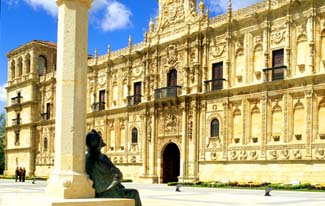
Photos courtesy of Parador de León
Plaza de San Marcos, 7
24001 León
Tel: ++34 987 23 73 00
Fax: ++34 987 23 34 58
Official parador website
Reserve with Booking.com
226 rooms
Double rooms: 80–472 euros
Single rooms: 80% of double
room rate
Rates include tax.
Free Wi-Fi
Open: all year
León is well served by train and bus. To reach the hotel, go to the town center. Next to the Bernesga River is a roundabout with a fountain in the middle. A signpost directs you north along the river to the hotel.
Nearby: horseback riding; golf; tennis; fishing; hunting; the medieval city of León and its cathedral
This outstanding Renaissance building ranks as León’s third most popular tourist site after the cathedral and the Basilica of St. Isidore. The parador’s Plateresque façade measures 328 feet long and 2 stories high. The friezes, columns, and pilasters are amazing. Medallions in relief depict famous personalities from the Bible and Roman and Spanish history. Events from the life of St. James, (including his legendary slaying of 1000s of Moors) are depicted in Baroque ornamentation over the main entrance.
The lobby is like a small museum with carvings, tapestries, and paintings hung beneath a 16th-century vaulted ceiling. The hotel’s public rooms are furnished with both antiques and reproductions. Cloisters standing two stories high surround a courtyard garden planted with ivy, shrubs, and trees.
Some guest rooms have four-poster beds and views of the cloisters; others have views of the parking lot. But any room allows you to relive history in an indulgent manner undreamed of by any pilgrim trudging across Spain to Santiago de Compostela.
An elegant dining room looks out on the river.
![]() The castle’s parade ground is used for theatrical, dance, and zarzuela performances during the summer months.
The castle’s parade ground is used for theatrical, dance, and zarzuela performances during the summer months.